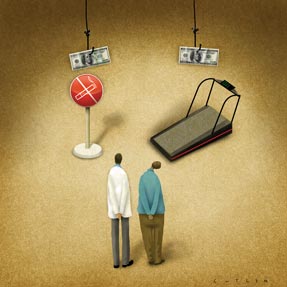Sustained change a challenge for health
Health-linked incentives have become increasingly common, particularly by employers. But researchers are still trying to sort out what type and design of incentives are most effective and whether they hold significant potential to achieve both short- and long-term behavioral changes.
Convincing patients to shed pounds and adopt other healthy habits, already a steep climb against human nature, isn't necessarily made much easier by financially compensating patients or doctors, according to research to date. Financial incentives can help, but only some of the time, as their design makes a big difference in their effectiveness.
Health-linked incentives have become increasingly common, particularly initiated by employers. By 2015, 38% of large employers and 15% of smaller ones reported offering workers a financial incentive to participate in or complete some type of wellness program, according to the most recent employer health benefits survey from the Kaiser Family Foundation and the Health Research & Educational Trust. But researchers are still trying to sort out what type and design of incentives are most effective and whether they hold significant potential to achieve both short- and long-term behavioral change.

To date, incentives have been most frequently tied to reductions in health insurance premiums, although in some studies they have been directly paid to participants or withheld if the health goal is not met. In a few studies, with an eye toward quality-driven reimbursement, some researchers have looked at paying doctors or practices.
Among the questions these studies are attempting to answer: How much money makes a motivational difference, and in what form? Can some of the lessons of behavioral economics be incorporated to design these wellness efforts? And can these habits be sustained, even after the incentive is withdrawn?
Participants “may do something in part because they're getting this incentive initially,” said Kevin Volpp, MD, PhD, FACP, who directs the Center for Health Incentives and Behavioral Economics at the University of Pennsylvania. “However, 1 of our goals is to achieve sustained changes in behavior that will continue even after an incentive program is taken away.”
Some headway has been made in terms of using incentives to convince people to stop smoking, said Dr. Volpp, a professor at the Perelman School of Medicine and the Wharton School in Philadelphia and a staff physician at the Crescenz VA Medical Center there. Multiple studies have shown tripling of long-term smoking cessation rates using financial incentives. In other areas, such as weight loss and physical activity, it's been more difficult to achieve success, and work is ongoing, he said.
While individuals should be provided with ways to improve their health, it's important that any related incentives not be unfairly designed, even inadvertently, said Ana María López, MD, MPH, FACP, who chairs ACP's Ethics, Professionalism and Human Rights Committee. (In 2010, ACP published a position paper about patient incentives and ethical considerations.) For example, an employer or a health plan might offer workers access to a weight loss program, but tying their health premiums to achieving a specific weight loss goal is more problematic, Dr. López said.
“We have to be really careful about being punitive because there may be factors, whether it's hereditary or whether it's metabolic,” she said. “There could be lots of factors that could make weight loss easier or more difficult for people that's not something that's necessarily within their control.”
Show me the money
If financial incentives are offered, 1 challenge involves how they should be designed, as different designs have very different effects, according to Dr. Volpp. If someone is handed a check or a gift card with several hundred dollars on it, the reward will likely feel much more tangible than that same amount deducted from an insurance premium in much smaller amounts over the course of a year, he noted. “Bundling incentives into health insurance premiums that are direct-deposited in paychecks has the downside of making the transactions fairly invisible,” he said.
Dr. Volpp and other researchers at the University of Pennsylvania wanted to assess whether premium reductions are ineffective. Their study, published in January 2016 by Health Affairs, followed nearly 200 obese employees charged with losing at least 5% of their body weight within 12 months. One group would get their $550 annual premium reduction—broken out over 26 weeks of paychecks—as soon as they met their weight loss goal, while the other would receive it the following year. But neither group achieved a significantly higher amount of weight loss compared with the control group, who wasn't offered any money.
On the other hand, paying cash more directly appears to pay off, at least where quitting smoking is concerned. Putting a significant chunk of money on the line, potentially as much as $800 per individual, tripled long-term smoking cessation rates, according to a randomized study involving 2,538 CVS employees and their dependents that was published May 28, 2015, in the New England Journal of Medicine.
In 1 of the 2 approaches tested in the study, individuals could earn the money in $200 installments if biochemical testing demonstrated that they had remained smoke-free for 6 months. By then, 15.7% of patients in the first group had met that threshold. So had 10.2% in the second group, who were asked to put a $150 deposit down, which they would get back if they stayed smoke-free, along with an additional $650.
Staying away from cigarettes over the longer term, not surprisingly, proved to be a bigger hurdle. At 1 year, 6 months after the monetary incentives ended, 8.1% of patients in the reward group and 4.7% in the individual deposit group could prove abstinence. In the control arm, in which participants got access to education about cessation (and, for CVS employees, free nicotine-replacement therapy), 3.4% were smoke-free at 12 months. From the perspective of employers, the authors note, that $800 cost of the incentive per employee pales next to the nearly $6,000 more it costs annually to employ a smoker versus a nonsmoker.
But how much money is needed to make a motivational difference? The answer likely depends on the population involved and the steepness of the health challenge, according to Dr. Volpp. To convince someone to fill out a health assessment questionnaire, $50 might be sufficient, he said, but a much higher figure might be needed to convince someone to stub out that last cigarette.
A loss or a gain?
Leveraging human psychology, on an individual or group level, also appears to ramp up motivation, according to the findings from several recent studies. One of the studies, which Dr. Volpp also was involved with, illustrated the effect of what behavioral economists describe as “loss aversion.”
The initiative, which was trying to encourage 281 overweight or obese employees at the University of Pennsylvania to walk at least 7,000 steps daily, used 3 different financial approaches plus a control arm, all 3 built around the possibility of earning $1.40 every day the step goal was achieved. All 4 randomized groups received daily feedback on whether they'd achieved that goal.
In the lottery group, participants who had met the prior day's steps had a chance of winning either $5 or $50. In the second group, participants earned $1.40 for each day they met their step goal. In the final group, they started with $42 already set aside in an account, and it was deducted in $1.40 daily increments if the 7,000 steps weren't achieved. Only that loss-motivated group posted a significantly higher number of step days during the 13-week study—45% of the time versus 30% in the control group, according to the results, published in the March 15, 2016, Annals of Internal Medicine.
“It was roughly 50% more effective than the control group,” Dr. Volpp said. “It's exactly the same amount of money that was offered in the gain-based incentive, but we in essence just reframed it as a potential loss.” Technically it's not a loss, he pointed out, because all participants could only end up with more money than if they hadn't participated. It is more akin to a frozen carrot in this sense than a stick, he said.
That effort, though, wasn't maintained. For the 13 weeks after the incentives ended, the loss group still had the highest average of step days, but it wasn't statistically significant compared to the control group.
In another study, involving money and weight loss, researchers tried to motivate people with some built-in elements of uncertainty. “This has come up a lot in the incentive literature—the element of ongoing engagement, of novelty,” said ACP Member Jeffrey Kullgren, MD, MPH, one of the study's authors, “to keep individuals interested and engaged and continuing to strive to achieve certain goals.”
The study design also tapped into people's tendency toward optimism regarding their ability to change behavior, said Dr. Kullgren, a research scientist at the VA Center for Clinical Management Research, part of the VA Ann Arbor Healthcare System in Michigan. During the 24-week study, 105 obese employees at Children's Hospital of Philadelphia were placed into 2 intervention groups. The first group was told they would individually receive $100 for each month that they met their weight loss goal. In the second group, the employees were pooled into clusters of 5, which proved to be a more effective approach. The carrot: The $500 would be divvied up between whichever participants met the goal.
The group participants shed an average of 10.7 pounds across the 24 weeks, which was significantly higher than the individual and control groups, who lost 3.7 and 1.1 pounds respectively, according to the findings, published in the April 2, 2013, Annals of Internal Medicine. Dr. Kullgren theorized that it helped that the groups didn't know their other members other than that they were fellow employees. That way they couldn't sabotage each other's weight loss efforts, he said. Plus, they had room to dream. “You might really think you're going to be the only 1 in the group to meet your weight loss goal,” he said, thus envisioning a check potentially as high as $500 for that month.
Motivating doctors
In the case of doctors, though, it appears that individually targeted incentives can be somewhat influential, at least based on the findings of a hypertension-focused study. The study, which targeted payments of $9.10 per hypertension-targeted measure, looked at paying individual doctors, paying the practice as a whole, or using a combined measure that included both the practice and the doctors.
The individual physicians showed the most change in terms of tackling hypertension, an improvement that correlated with improving prescribing and blood pressure control in 84 additional patients out of a panel size of 1,000, according to the findings, published in the Sept. 11, 2013, Journal of the American Medical Association. The doctors received the $9.10 per measure met, with a maximum of $18.20 per patient. But no statistically significant improvement, compared with the control group, was identified for the physician practices or the combined group measurement.
Laura Petersen, MD, MPH, FACP, a study author, said the findings countered her initial hypothesis that group incentives would be more effective. One possibility is that it was more difficult to show improvement, since the bar was already relatively high; roughly three-quarters of patients treated in the VA system already have their blood pressure under control, said Dr. Petersen, who directs the Center for Innovations in Quality, Effectiveness and Safety at the Michael E. DeBakey VA Medical Center in Houston.
But group dynamics also may have come into play, she said, citing the potential for a “free rider” ripple effect. “If I'm in a group and I think you're going to do the right thing, and I'm going to benefit, why should I make the extra effort? I'll just kind of coast on your effort.” Meanwhile, individual doctors feel like if they personally do the right thing, they will benefit and don't have to worry about what the rest of the group is doing, Dr. Petersen said.
As reimbursement increasingly gets tied to improved quality, it will be important to find ways to better motivate doctors and patients alike, Dr. Petersen said. Dr. Volpp agreed, pointing out that financial incentives for patients don't have to be in the form of cash. One avenue would be to waive the cost of preventive drugs, such as statins, when a practice is part of a larger hospital system, he said.
Physicians also might offer a discount on a patient's office visit for those who enroll in a specific class, such as for nutrition or weight loss, Dr. López said. But in designing these incentives, doctors should ensure that the class or program can be taken advantage of by all patients, even if it means offering it on the weekend, so no one is shut out of the opportunity and the discount, she said.
Patients aren't the only ones who struggle with sustained change, as Dr. Petersen learned. Her study, which paid incentives for a dozen hospital-based primary care clinics for 16 months, shut down the payments as well as the automated feedback on the hypertension measures at the end of that period.
Then the researchers did a post hoc analysis after a subsequent year without any physician contact. Dr. Petersen had hypothesized “that their practice would be solidified around these guidelines, and that there would be a permanent change in behavior.” But the study found that the new habits didn't hold up once the incentive payments had stopped.
“It's not financially sustainable to just continue these incentives forever,” Dr. Petersen said. “We are going to have to think of clever ways to ensure that the effects are sustainable.”




